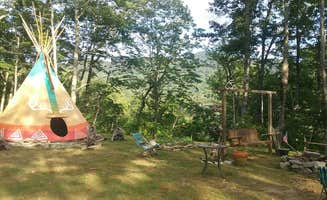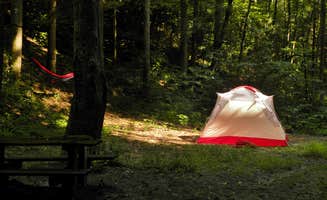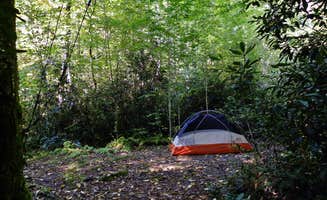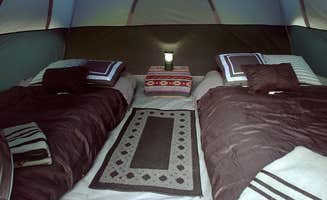Tent camping opportunities near Cherokee, North Carolina range from primitive backcountry sites to drive-in campgrounds with amenities. Located at elevations between 1,700 to 6,000 feet, the area experiences temperature variations of 10-15 degrees between valley floors and mountain peaks. Most campgrounds within Great Smoky Mountains National Park enforce strict food storage regulations due to active black bear populations throughout the region.
What to do
Hiking at Cosby Campground: Trails lead directly from campsites to surrounding mountain peaks. "Great sites available without reservations. Trailheadss conveniently located inside the campground. Peaceful trails," notes Stephani K. about Cosby Campground.
Swimming in creek pools: Big Creek offers natural swimming areas just steps from camp. "It was great for the dogs to cool off. There are also swimming holes nearby," says Katrin M. about Big Creek Campground.
Exploring historic structures: Several trails pass abandoned homesteads with intact buildings. "The trail itself passes by a house and a spring house that were built before the land was turned into a national park. You can actually go inside the house and explore its rooms," explains a camper at Site 40.
Wildlife viewing: Dawn and dusk provide opportunities to see elk herds in meadow areas. "One unforgettable morning, we were greeted by a friendly deer that sauntered by, offering us a charming 'good morning' as it grazed peacefully on the surrounding grasses," shares a visitor to Laurel Gap Shelter.
What campers like
Secluded atmosphere: Many campgrounds offer privacy despite proximity to park attractions. "Cosby Campground tends to be a little quieter than Cades Cove or Elkmont, but I like it that way! There is ample parking nearby and trailheads," reports Jessica L. about Tricorner Knob Shelter.
Water features: Streams and creeks run through many camping areas. "The camp was great. Pads were large and flat and well kept... Nice path to walk and explore along stream which is very beautiful," shares Nick about Big Creek Campground.
Smaller crowds: Some areas receive fewer visitors than main park entrances. "Was directed to Cosby by a NPS Ranger as an overlooked, beautiful campground. Arrived close to dark and had our pick of gorgeous, wooded sites- even on a weekend in July," says Tricia L.
Natural surroundings: Vegetation provides shade and privacy at most sites. "Private tent areas completely covered by rhododendron!" notes Brent S. about Site 40.
What you should know
Reservation requirements: Most backcountry sites require permits obtained through the park's reservation system. "The shelter itself is a classic three-sided AT shelter. Remember that all overnight stays (other than AT thru-hikers) must be reserved through the GSMNP backcountry office or online," explains Bill S. at Tricorner Knob Shelter.
Space limitations: Some popular shelters fill quickly during peak seasons. "The shelter and its surrounding camping areas were not able to accommodate the influx of hikers. Space was at a premium, and it felt exceptionally crowded," warns a camper at Laurel Gap Shelter.
Wildlife precautions: Bears frequently visit camping areas. "When I was there, I saw what I believe to be at least two large piles of bear scat... Garbage is the main reason the bears are aggressive," cautions Myron C. about Site 40.
Weather variations: Higher elevation sites experience significant temperature drops. "The area around the shelter is high, rocky, and remote. Expect 10-15 degrees less than the Park headquarters," advises Bill S.
Tips for camping with families
Accessible camping options: Some sites require minimal walking from parking areas. "You cannot park your car right on the campsite. There is a parking lot and you need to carry your gear in. It's about 100 feet to the sites," explains Katrin M. about Big Creek Campground.
Private sites for group camping: Larger families need spacious sites with natural boundaries. "Gateway to the Smokies is a small family owned and operated campground with two very large and private campsites on over an acre of land," notes Michael G. about Gateway to the Smokies.
Ranger programs: Educational activities run throughout summer months. "On Fridays they have special Ranger programs. We were lucky enough to learn about moon-shining from guys on the moonshiner TV show," shares Janine B.
Stream access for play: Water features provide natural entertainment for children. "I love the waterfalls on this property. They are so soothing to listen to as we grill out, sit at the fire pit, and play in the water," says Liz L. about Gateway to the Smokies.
Tips from RVers
Hookup availability: Most park campgrounds have limited or no hookups. "There is a small Elvis museum onsite, but it is impressive with all of the Elvis memorabilia. There is also a stream behind the campground which is great to sleep by and great for fishing for trout," reports Myron C. about Littlejohn Campground, which offers electric and water hookups.
Road access considerations: Some campgrounds have challenging approach roads. "Plan to be without WiFi and for your car to navigate difficult ground on your way in and out," warns Alison W. about Big Creek.
Noise factors: Road proximity affects some camping experiences. "This was my third time at Littlejohn Campground, and it was during the middle of the week. There wasn't a lot of activity except for the noise from the road," notes Myron C.
Site size restrictions: Vehicle length limitations apply at most park campgrounds. "Most sites are shady and there are fire pits. The bath house is adequate, but if I had been in an RV, I think I would have rather used it," explains a camper at Littlejohn Campground.













